A grassroots movement for social equality arises in New York City. Members of the movement take to the streets to protest agains the system that allows rich elites to lord over the working class. The mayor, who’s in league with the rich elites, uses thin legal pretenses to order the NYPD to brutally crack down on the protesters. But the movement lives on, takes to the streets again, and makes good on their promise that the world (World) will know their struggle.
Am I talking about the Occupy Wall Street movement…
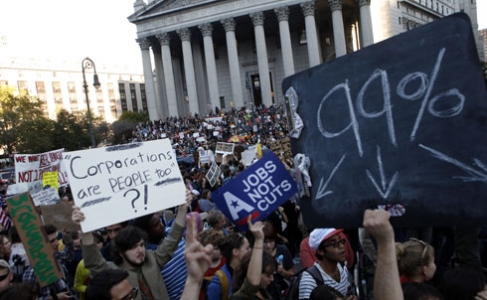
…or the plot of the Disney musical Newsies?
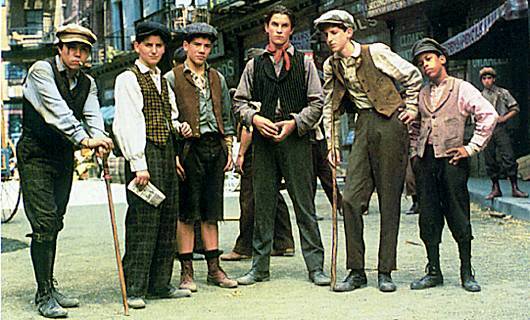
I’m not the first to point out the connections between Newsies and the Occupy Wall Street movement. As the stage adaptation prepares to occupy a Broadway theater in March 2012, media observers have pointed out the parallels and even asked the show’s producers if there’s anything to it, but they have shrugged it off as mere coincidence. They’re largely right to do so, since the musical has been in the works years before occupations and the 99% were part of the national discourse.
But Newsies has the odd distinction of being one of the few movies about large scale social justice protest movements set in New York City, and as such, it’s begging for people to look for the parallels between it and OWS. For the most part, those parallels break down once you get past the broad plot summary, but the differences between the strike as depicted in Newsies and the OWS movement can lead to some insights on both.
“Even though we ain’t got hats or badges / we’re a union just by saying so…”
Newsies is not ambiguous at all about its positive stance on labor unions. Early in the film, newsboy leader David Jacobs laments that his father was fired from his job after his injury because he had no union to protect his position. Later, as the newsboys make their final push against Joseph Pulizter, they enlist thousand of other young workers across the city to walk off their jobs in solidarity with them. Even though all those young workers may not have been unionized, or even organized in any sense of the word, their work stoppage was nothing short of an organized labor action, a strike, and as the film tells it, the strike eventually led to legislation that curtailed the abusive child labor practices of the day.
http://www.youtube.com/watch?v=_dw9GJKTrqg&start=169
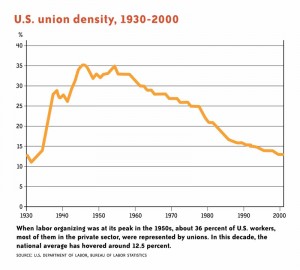 Occupy Wall Street, however, is not a labor movement or organization of workers in any sense of the word. The movement’s ambiguous, all-encompassing “99%” nature means that it’s not defined by a common occupation or opposition to a specific employer. Unions came to OWS after the movement had gained steam and were not part of its early organization or successes. And some within the movement view labor unions as part of an ineffectual “institutional left” that will ultimately harm more than hurt the movement’s progress.
Occupy Wall Street, however, is not a labor movement or organization of workers in any sense of the word. The movement’s ambiguous, all-encompassing “99%” nature means that it’s not defined by a common occupation or opposition to a specific employer. Unions came to OWS after the movement had gained steam and were not part of its early organization or successes. And some within the movement view labor unions as part of an ineffectual “institutional left” that will ultimately harm more than hurt the movement’s progress.
So why does this matter? It’s a perfect illustration of how the role of the labor union in the United States has vastly changed in the 100 years between the events of Newsies and OWS. Or for that matter, the twenty years between the release of Newsies and OWS. Unions, once the standard bearers of progressive movements and staples of American middle class life, have seen their membership roles steadily decline since their peaks in the 1950’s. More importantly, their members are often vilified as the unfireable, overpaid, unproductive teachers, factory workers, and civil servants who are preventing our nation from remaining competitive with India and China.
In other words, the Newsies story of labor unions representing the 99% and triumphing over the 1% is not likely to have resonance with the Occupy Wall Street movement and its members, most of whom have probably never been in a union in their lives and hardly see themselves as “striking” against anyone.
“The newsies were a ragged army, without a leader. Until one day, that all changed.”
 “Leader” being the operative word in the above quote from the beginning of Newsies. Both the film and historical accounts of the 1899 newsboys strike place great importance on the union’s leader. In the movie, Jack Kelly is clearly the catalyst for action and the unifier of an otherwise un-unifiable group. And he’s also the target of Joseph Pulitzer, who tries to buy out Jack and demoralize the movement with the site of the co-opted leader-turned-shill.
“Leader” being the operative word in the above quote from the beginning of Newsies. Both the film and historical accounts of the 1899 newsboys strike place great importance on the union’s leader. In the movie, Jack Kelly is clearly the catalyst for action and the unifier of an otherwise un-unifiable group. And he’s also the target of Joseph Pulitzer, who tries to buy out Jack and demoralize the movement with the site of the co-opted leader-turned-shill.
OWS on the other hand, is famous for its consensus-based decision making and its lack of public leadership. Behind the scenes, the movement has an identifiable “cadre of prime movers,” but publicly, no single person goes on the talk show circuit representing OWS. More importantly, no single person meets with Barack Obama, union leaders, Jay-Z, or any of the parade of people accused of trying to co-opt OWS to serve their own purposes.
Pulitzer has no Jack to buy off. Or, as Jesse Jackson more pointedly observed, “there’s nobody to assassinate.”
“Dreams come true / Yes they do, in Santa Fe”
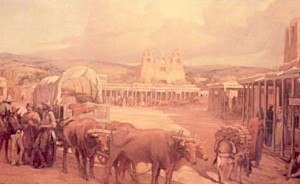 As Belinkie pointed out in a previous article on this site, “Santa Fe” is Jack’s expression of an unrealistic fantasy, a western dream-land that promises prosperity and an escape from the gritty New York life. But behind that fantasy was the reality that America at the turn of the century still had a undeveloped frontier that offered considerable commercial opportunity for anybody willing to move there and tame the wilderness.
As Belinkie pointed out in a previous article on this site, “Santa Fe” is Jack’s expression of an unrealistic fantasy, a western dream-land that promises prosperity and an escape from the gritty New York life. But behind that fantasy was the reality that America at the turn of the century still had a undeveloped frontier that offered considerable commercial opportunity for anybody willing to move there and tame the wilderness.
This backup plan looms over Jack throughout the movie. Even after he leads the striking newsboys to victory over Pulitzer, he still has Santa Fe as an option, and he strongly considers it before staying New York to get the girl and…keep selling newspapers at pittance wages.
Fast forward to the 21st century. The frontier, the undeveloped land of future prosperity, is no longer in America–it’s in the aforementioned “emerging markets” of India and China. And even to the extent that freedom of movement around America still offers greater exposure to economic opportunity, that too is limited due to the mortgage crisis that has people stuck in homes they can’t sell. In 2010, domestic migration in the United States had dropped to the lowest level since 1947, the first year that the government tracked these rates.
The America of OWS doesn’t have a Santa Fe escape valve. OWS is trapped within the 1%-controlled fishbowl of the United States, and with nowhere else to go, it chooses to agitate for change here.
Conclusion
I highly doubt that the “cadre of prime movers” of the Occupy Wall Street movement are losing sleep searching for the right movies to inspire their cause. And even though it’s not out of bounds for social movements to take their cues from pop culture (e.g., Uncle Tom’s Cabin), I doubt that a Broadway musical that’s based on a 20 year old movie would have much influencing power over OWS, even if their themes were more closely aligned.
But Newsies is still a small and, dare I say, important part of our collective imagination around social change movements, and probably one of the most popular movie depictions of protest movements in New York City. Given this, and the aforementioned similarities with OWS, it has a valid place in the conversation around OWS, even if the insight it provides on OWS is more the result of its differences with OWS than its similarities.
Although there’s one lesson that I think OWS can draw from Newsies: they should replace the drumming with toe-tapping Disney tunes and choreographed dancing:
http://www.youtube.com/watch?v=jPud_H94_i4&feature=related
Now that’s what I call entertainment for the 99%.
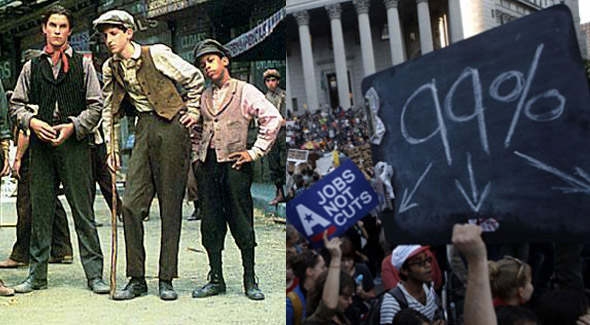
Please tell me you’re going to see the show when it hits the stage? My birthday is in March, it could be a vicarious present. ;p
In all seriousness, I didn’t read that article you linked to (eight pages, and I’m only taking a short break), but I do find some of the tactics, or rather the lack thereof, of OWS are likely going to lead to it either accomplishing a whole lot of nothing or, worse, giving what it’s meant to oppose more strength. The lack of cohesion means there is no solid message for which to advocate. The newspaper boys succeeded because they were not only united around Jack, but around a more solidified idea, one with clear policy outcomes. And their protests were aimed at a very specific place. OWS, on the other hand, is pointing fingers in myriad directions- and, importantly, at the closest they’d have to a political machine ally, the Democratic party. Granted, both major parties are pretty corporate-driven, but if OWS rejects the Democratic Party, the party more likely to be sympathetic to its cause (and I use that word loosely), there is likely no chance any policy changes favorable to its message will be achieved. And its lack of message, as I said, means it’s not even really advocating for distinct policy change in the first place. Further, the lack of cohesion means there is less likelihood of an electoral change. The Tea Party movement was able to get a number of people elected within the Republican Party, but Democrats are not coming out in support for OWS the way Republicans did for the Tea Party. And again, if OWS protests at the Democratic Convention, too, it’s unlikely it will get support from Democrats.
The somewhat ironic thing is that OWS really could learn a lot from The Newsies. If it did less contrasting and more paralleling, took its example from those kids, it could actually be more likely to see change.
And one more thing, although perhaps I risk being a bit too political. Should OWS actually get support among Democrats, there could be problems for the Democratic party. The movement isn’t really strong enough to get a majority, but it could case a split within the party over current Democratic seats- and since a plurality, not a majority, is necessary to win most elections in the US, it could lead to Republican takeovers of previously Democratic seats. So then the party less likely to be on OWS’s side will gain more power, thereby making any OWS-happy policy changes even more distant. Tough situation. Principles or pragmatism?
One historical example that OWS reminds me a lot of is the hippie sub-culture of the late sixties. Like OWS, the hippies were a loosely unified group of people with no clear unified goals or directives. Some of them participated in protests, but depending on who you spoke to, hippies could have been anti-war protesters, civil-rights activists, proponents of sexual or drug-related subcultures, or just young people who wanted to be part of a movement.
While I agree with many of the causes that OWS seems to support, I avoid self-identifying with the group for many of the exact reasons that Gab mentions above. And I agree with Gab in that OWS seems unlikely to effect any real policy change. My inner optimist, however, hopes that like the hippies of the60s, OWS may be more successful in a general sense by raising public awareness of certain business practices and affecting a more culture-wide change over the populace that politicians will eventually have to accommodate.
Your last sentence is exactly how I feel, too. :)